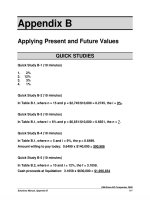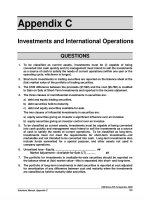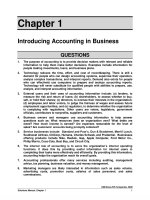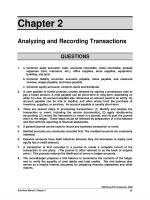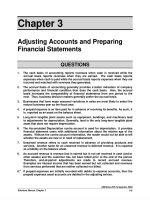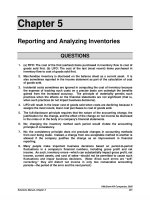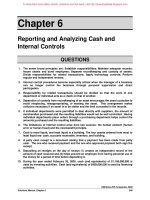Solution manual financial accounting by valix ch5 7
Bạn đang xem bản rút gọn của tài liệu. Xem và tải ngay bản đầy đủ của tài liệu tại đây (119.91 KB, 24 trang )
53
CHAPTER 5
Problem 5-1
Problem 5-2
Problem 5-3
1.
2.
3.
4.
5.
1. C
2. C
3. A
4. B
5. A
1. B
6.
2. A
7.
3. A
8.
4. D
9.
5. A
10. C
C
B
B
C
D
6. A
7. C
8. B
9. D
10. D
A
B
B
B
Problem 5-4 Answer A
Cost
Accumulated depreciation (3,000,000 / 6 x 3)
Book value – January 1, 2008
3,000,000
1,500,000
1,500,000
Depreciation for 2008 (1,500,000/5)
300,000
Problem 5-5 Answer A
Cost
Accumulated depreciation (2,640,000 / 8 x 3)
Book value – January 1, 2008
Accumulated depreciation – January 1, 2008
Depreciation for 2008 (1,650,000 – 240,000 / 3)
470,000
Balance – December 31, 2008
2,640,000
990,000
1,650,000
990,000
1,460,000
Problem 5-6 Answer D
Straight line depreciation for year 2008 (1,536,000 / 8)
192,000
Problem 5-7 Answer C
Cost – 1/1/2006
6,000,000
Accumulated depreciation – 1/1/2008 (6,000,000 – 600,000 x 20 x 2)
540,000
Book value – 1/1/2008
5,460,000
Depreciation for 2008 (5,460,000 – 800,000 / 10)
466,000
54
Problem 5-8 Answer A
Patents – 1/1/2003
Accumulated amortization (3,000,000 / 10 x 5)
Book value – 1/1/2008
3,000,000
1,500,000
1,500,000
Amortization of patents for 2008 (1,500,000 / 3)
500,000
Depreciation for 2008 (4,600,000 – 200,000 / 10)
440,000
Total charge against 2008 income
940,000
Problem 5-9 Answer D
Inventory
Retained earnings
600,000
600,000
Problem 5-10 Answer A
Inventory – January 1, 2008:
Weighted average
FIFO
7,200,000
Effect of change – increase in inventory
500,000
7,700,000
Problem 5-11 Answer C
Percentage of completion
Cost recovery method
Cumulative effect – understatement of income
Tax (35% x 2,000,000)
( 700,000)
Net cumulative effect
9,000,000
7,000,000
2,000,000
1,300,000
The change from cost recovery method to percentage of completion is a change
in accounting policy. Accordingly, the cumulative effect is an adjustment of
retained earnings.
Problem 5-12 Answer A
2005
2006
Percentage of completion
15,000,000
16,000,000
Cost recovery method
7,000,000
13,000,000
2007
Total
7,000,000
38,000,000
12,000,000
32,000,000
Cumulative effect (38,000,000 – 32,000,000)
6,000,000
55
Problem 5-13 Answer A
Only the unrecorded warranty cost of P100,000 on December 31, 2007 should be
accounted for as a prior period error. The change from straight line to
accelerated depreciation is a change in estimate and therefore should be treated
currently and prospectively.
Problem 5-14 Answer B
Retained earnings (2,000,000 / 5)
Depreciation
Accumulated depreciation
400,000
400,000
800,000
Problem 5-15 Answer A
Retained earnings – January 1, 2008
850,000
Prior period errors – underdepreciation:
2006
2007
Corrected beginning balance
Net income for 2008
500,000
Retained earnings – December 31, 2008
1,300,000
(
(
25,000)
25,000)
800,000
Problem 5-16 Answer B
Net income
Unrealized gain on available for sale securities
Foreign currency translation loss
50,000)
Revaluation surplus
1,000,000
Net amount
4,700,000
Problem 5-17 Answer C
3,500,000
250,000
(
Income from continuing operations
Unrealized loss on available for sale securities
Casualty loss
Foreign currency translation gain
Comprehensive income
8,500,000
10,000,000
( 2,000,000)
( 500,000)
1,000,000
Comprehensive income as an American term and this is the same as the
concept of recognized gains and losses. The dividend paid is a deduction from
retained earnings.
56
Problem 5-18
Building
15,000,000
Accumulated depreciation (15,000,000 / 15 x 3)
3,000,000
Book value – December 31, 2007
12,000,000
Machinery
10,000,000
Accumulated depreciation (10,000,000 / 10 x 3)
3,000,000
Book value – December 31, 2007
7,000,000
Furniture and fixtures
3,500,000
Accumulated depreciation (3,500,000 / 7 x 3)
1,500,000
Book value – December 31, 2007
2,000,000
Depreciation for 2008:
Building (12,000,000 / 10)
1,200,000
Machinery (7,000,000 / 7)
1,000,000
Furniture and fixtures (2,000,000 / 5)
400,000
Total depreciation
2,600,000
Problem 5-19
Equipment – January 1, 2004
4,000,000
Accumulated depreciation (4,000,000 – 400,000 / 10 x 4)
1,440,000
Book value – December 31, 2007
2,560,000
Revised annual depreciation (2,560,000 – 460,000 / 7)
300,000
Problem 5-20
1.
A change in accounting policy made voluntarily is accounted for
retrospectively.
2. A change in accounting policy required by an accounting standard is
accounted for as required by the transitional provisions. If there are no
transitional provisions, the change is recognized retrospectively.
3. A change in residual value is a change in estimate and therefore accounted
for
currently and prospectively.
4. An immaterial error can be ignored or corrected in the current year as a
component of income of the current year.
5. A material error is accounted for retrospectively. Undue cost and effort would
not be an acceptable excuse for retrospective application.
57
Problem 5-21
Reliable Company
Statement of Retained Earnings
Year Ended December 31, 2008
Retained earnings – January 1
Prior period error – overdepreciation in 2007
100,000
Change in accounting policy from FIFO to weighted average
method – credit adjustment
150,000
Corrected beginning balance
Net income
Decrease in appropriation for treasury share
200,000
Total
Cash dividends paid to shareholders
( 500,000)
Current appropriation for contingencies
( 100,000)
Retained earnings – December 31
200,000
450,000
1,300,000
1,950,000
1,350,000
Problem 5-22
Net income
Loss from fire
(
50,000)
Goodwill impairment
( 250,000)
Loss on sale of equipment
( 200,000)
Gain on retirement of bonds payable
Gain on life insurance settlement
Adjusted net income
3,000,000
100,000
450,000
3,050,000
Gondola Company
Statement of Retained Earnings
Year ended December 31, 2008
Balance – January 1
Compensation of prior period not accrued
Correction of prior period error – credit
Adjusted beginning balance
Net income – adjusted
Stock dividend
Loss on retirement of preference share
Appropriated for treasury share
(1,000,000)
Balance – December 31
3,500,000
2,600,000
( 500,000)
400,000
2,500,000
3,050,000
( 700,000)
( 350,000)
58
Problem 5-23
Angola Company
Comparative Income Statement
Years ended December 31, 2008 and 2007
2008
2007
Sales
Cost of goods sold
Gross income
Expenses
Net income
6,000,000
4,500,000
(2,900,000) (2,300,000)
3,100,000
2,200,000
(1,490,000) (1,800,000)
1,610,000
400,000
Angola Company
Comparative Statement of Retained Earnings
Years ended December 31, 2008 and 2007
2008
2007
Retained earnings – January 1
Net income
Dividends paid
Retained earnings – December 31
1,250,000 1,000,000
1,610,000
400,000
( 500,000)( 150,000)
2,360,000 1,250,000
Problem 5-24
Martha Company
Statement of Changes in Equity
Year ended December 31, 2008
Balances – January 1
Issuance of preference
Purchase of treasury ordinary
320,000
Issuance of ordinary
Dividend to ordinary
Reissuance of TS
(160,000)
Dividend to preference
Overstatement of 2007
ending inventory
Net income
____
Balances – December 31
160,000
Ordinary
10,000,000
Preference
5,000,000
2,500,000
Share
premium
RE
TS
7,500,000 3,250,000
400,000
3,500,000
(2,480,000)
50,000
( 450,000)
_____ ____
12,500,000
__ _____
__ ______
5,000,000
( 130,000)
2,250,000
11,450,000
__
2,440,000
59
Problem 5-25
Carr Company
Statement of Changes in Equity
Year ended December 31, 2008
Ordinary
TS
Balances – January 1
270,000
Retirement of TS
Property dividend
5,150,000
( 150,000)
Preference
1,800,000
(
Share
premium
3,590,000
120,000)
RE
4,000,000
(270,000)
( 750,000)
Dividend to preference
Error
Net income
Balances – December 31
-___
( 180,000)
( 325,000)
________
_ _______
_ _______
2,600,000
_______
5,000,000
1,800,000
3,470,000
5,345,000
60
CHAPTER 6
Problem 6-1
Problem 6-2
Problem 6-3
1. A
2. A
1. D
2. B
1. B
2. A
3. A
3. B
3. B
4. C
4. C
4. A
5. D
5. B
6. B
7.
8.
9.
10.
C
D
A
C
5. C
6. B
7. C
8. A
9. B
10. A
Problem 6-4 Answer B
Property taxes (180,000 / 4)
45,000
Repairs – allocated to second, third and fourth quarters (300,000 / 3)
100,000
The expense for second quarter
145,000
Problem 6-5 Answer D
Depreciation
Bonuses
600,000 Total
850,000
250,000
Problem 6-6 Answer A
The casualty loss is reported in the period in which it is incurred. In this case, the
loss is incurred in the third quarter.
Problem 6-7 Answer D
Net income per book
Gain from expropriation incorrectly allocated (600,000 / 3)
Change in accounting policy incorrectly deducted from income
150,000
Corrected net income
950,000
(200,000)
900,000
61
Problem 6-8 Answer C
Advertising and bonuses are reported in the interim period when incurred.
PAS 34, paragraph 39, provides that cost incurred unevenly during a financial
year shall be anticipated or deferred for interim purposes only if it is also
appropriate to anticipate or defer such cost at the end of the financial year.
Problem 6-9 Answer A
Total warranty (10% x P25 million)
Warranty recognition in first quarter (5% x P10 million)
500,000
Warranty expense for second quarter
2,500,000
2,000,000
Problem 6-10 Answer B
First quarter – Gross income
5,000,000
Percentage of completion
Income earned
10%
500,000
Second quarter – No work done
0
Third quarter - Gross income
800,000
Percentage of completion
Cumulative income
Income earned – FQ
Loss in TQ
( 300,000)
Fourth quarter
25%
200,000
( 500,000)
0
Problem 6-11 Answer B
Problem 6-12 Answer B
Bad debt expense for the entire year
Bad debt expense:
First quarter (5% x 2,000,000)
Second quarter (5% x 1,500,000)
Third quarter (5% x 2,500,000)
Bad debt expense for fourth quarter
150,000
450,000
100,000
75,000
125,000
300,000
Problem 6-13 Answer A
First quarter:
Property taxes (600,000 / 4)
150,000
62
Second, third and fourth quarter:
Property taxes
Major repairs, (2,400,000 / 3)
800,000
Total
150,000
950,000
Problem 6-14
Question 1 - Answer B
Using just the annual sales data, it appears that the annual sales are increasing
by P10,000. Accordingly, the 2008 sales would be P60,000. A reasonable
forecast of the fourth quarter sales would be P60,000 divided by 4 or P15,000.
Question 2 – Answer A
Using the quarterly sales data, it appears that the fourth quarter sales are
increasing by P4,000. The best guess of the fourth quarter sales for 2008 would
be P20,000 plus P4,000 or P24,000.
Question 3 – Answer C
Using the quarterly sales data, the first quarter sales appear to increase by
P2,000. However, the actual increase in 2008 is twice as much from P10,000 to
P14,000. If this trend continues, sales for the fourth quarter of 2008 would also
be twice as much. Under this assumption, the best guess of the fourth quarter
sales for 2008 would be P20,000 plus P8,000 or P28,000.
Problem 6-15 Answer A
Sales (30% x 6,000,000)
1,800,000
Cost of goods sold (60% x 1,800,000)
(1,080,000)
Gross income
Variable expense (30% x 400,000)
( 120,000)
Fixed expenses (100,000 / 4)
(
25,000)
Casualty loss
( 300,000)
Income before tax
720,000
275,000
The gain on sale of equipment is reported in the second quarter, not in the
third quarter, because the equipment is sold on June 1, 2008.
63
Problem 6-16
Chairmaine Company
Income Statement
Three-month ended March 31, 2008
Sales
Cost of sales (60%)
Gross income
Interest income (5,000,000 x 12% x 3/12)
Total income
Selling expenses
Administrative expenses
Income before tax
Income tax (35%)
( 1,312,500)
Net income
25,000,000
15,000,000
10,000,000
150,000
10,150,000
( 3,350,000)
( 3,050,000)
3,750,000
2,437,500
Selling expenses
Depreciation (450,000 x 1/3)
Total
3,200,000
150,000
3,350,000
Administrative expenses
Depreciation (450,000 x 2/3)
Insurance (400,000 / 4)
Doubtful accounts (25,000,000 x 1%)
Total
2,400,000
300,000
100,000
250,000
3,050,000
Chairmaine Company
Balance Sheet
March 31, 2008
ASSETS
Current assets:
Cash
Trade and other receivables
Inventory
Prepaid insurance
6,700,000
Noncurrent assets:
Note receivable
Property, plant and equipment
Total assets
1,000,000
1,900,000
3,500,000
300,000
5,000,000
19,050,000 24,050,000
30,750,000
64
LIABILITIES AND EQUITY
Current liabilities:
Accounts payable
Income tax payable
Shareholders’ equity:
Share capital
Share premium
Retained earnings
20,937,500
Total liabilities and equity
Accounts receivable
Allowance for doubtful accounts
Accrued interest on NR
Total trade and other receivables
Inventory – 1/1
Purchases
GAS
Cost of sales
(15,000,000)
Inventory – 12/31
Land
Buildings and equipment
Accumulated depreciation
Net book value
Retained earnings – 1/1
9,500,000
Net income
Balance – 12/31
11,937,500
8,500,000
1,312,500
9,812,500
5,000,000
4,000,000
11,937,500
30,750,000
2,000,000
( 250,000)
150,000
1,900,000
1,500,000
17,000,000
18,500,000
3,500,000
1,500,000
18,000,000
( 450,000)
19,050,000
2,437,500
65
Problem 6-17
Dunhill Company
Income Statement
Six-month ended June 30, 2008
Sales
Cost of sales
Gross income
Interest revenue
Dividend revenue
Total income
Selling expenses
General expenses
Depreciation
Interest expense
Income before tax
Income tax expense
Net income
20,000,000
(11,500,000)
8,500,000
250,000
500,000
9,250,000
( 2,500,000)
( 1,100,000)
( 700,000)
( 300,000)
4,650,000
( 1,300,000)
3,350,000
Dunhill Company
Income Statement
Three-month ended June 30, 2008
Sales
Cost of sales
Gross income
Interest revenue
Dividend revenue
Total income
Selling expenses
General expenses
Depreciation
Interest expense
Income before tax
Income tax expense
Net income
12,500,000
( 7,000,000)
5,500,000
250,000
200,000
5,950,000
( 1,600,000)
( 600,000)
( 300,000)
( 200,000)
3,250,000
( 900,000)
2,350,000
Problem 6-18
First quarter (70% x 10,000,000)
Loss on inventory writedown
Cost of goods sold after inventory writedown
7,000,000
100,000
7,100,000
66
First and second quarters (65% x 18,000,000)
11,700,000
Cost of goods sold for first quarter before inventory writedown
( 7,000,000)
Cost of goods sold before reversal of writedown – second quarter
Gain on reversal of writedown
Cost of goods sold after reversal of writedown
4,700,000
(
100,000)
4,600,000
Third quarter (70% x 7,000,000)
4,900,000
Loss on inventory writedown
150,000
Cost of goods sold after inventory writedown
Cost of goods sold for entire year (75% x 40,000,000)
30,000,000
Cost of goods sold before writedown and reversal:
First quarter
7,000,000)
Second quarter
Third quarter
Cost of goods sold before reversal of writedown – fourth quarter
13,400,000
Gain on reversal of writedown
Cost of goods sold after reversal of writedown – fourth quarter
First quarter
Second quarter
Third quarter
Fourth quarter
Total
Sales
10,000,000
8,000,000
7,000,000
15,000,000
40,000,000
5,050,000
(
( 4,700,000)
( 4,900,000)
(
150,000)
13,250,000
Cost of goods sold
Gross income
7,100,000
2,900,000
4,600,000
3,400,000
5,050,000
1,950,000
13,250,000
1,750,000
30,000,000
10,000,000
67
CHAPTER 7
Problem 7-1
7-3
1. A
2. A
7. B
3. D
D
4. D
C
5. A
10. C
Problem 7-2
Problem
6. D
7. B
1. D
2. B
1. C
2. B
6. D
8. C
3. D
3. B
8.
9. B
4. C
4. B
9.
10. A
5. B
5. B
6. C
Problem 7-4 Answer B
Sales to unaffiliated customers
Intersegment sales
Total segment revenue
20,000,000
6,000,000
26,000,000
Revenue criterion (10% x 26,000,000)
2,600,000
Problem 7-5 Answer B
Total revenue
Percent
Alo
Bix
14.46%
Cee
Dil
71.08%
8,000
12,000
4,000
9.64%
4.82%
59,000
83,000
100.00%
Only Bix and Dil have a revenue of 10% or more of the combined revenue. It is to
be noted that the revenue includes both sales to unaffiliated customers and
intersegment sales.
Problem 7-6 Answer C
Total revenue
Profit
Assets
A
29.63%
B
25.93%
C
18.52%
D
11.11%
E
10.37%
F
4.44%
30.53%
30.17%
24.43%
24.14%
18.32%
20.69%
9.16%
9.48%
12.98%
11.64%
4.58%
3.88%
100.00%
100.00%
100.00%
A, B, C, D and E are reportable segments because their revenue or operating
profit or asset is at least 10% of the combined amount.
68
Problem 7-7 Answer B
V
W
X
Y
Z
Profit
Operating loss
3,400,000
1,000,000
2,000,000
400,000
200,000
4,800,000
2,200,000
The total profit figure is the basis for identifying the reportable segments
because it is higher than the total loss figure. Accordingly, those segments with
profit or loss of at least 10% of P4,800,000 or P480,000 are reportable. Thus, V,
W and X are reportable.
Problem 7-8 Answer C
Sales – Segment Z
Segment expenses:
Traceable operating expenses
Allocated indirect operating expenses
(600,000/2,400,000 x 360,000)
440,000
Profit
600,000
350,000
90,000
160,000
Segment expense does not include administrative expenses, head office
expenses and other expenses that arise at the enterprise level and relate to the
enterprise as a whole.
Problem 7-9 Answer D
Segment 1
Total revenue
Sales
3,000,000
Traceable costs
(1,750,000)
(5,000,000)
Profit before common cost
1,250,000
Common cost (1,250,000/2,500,000 x 1,500,000)
( 750,000)
(1,500,000)
Segment profit
500,000
7,500,000
2,500,000
1,000,000
Problem 7-10 Answer C
Sales – Segment A
Expenses:
Traceable operating costs
Allocated indirect costs (25% x 500,000)
2,025,000
Segment profit
3,000,000
1,900,000
250,000
975,000
Segment expense does not include interest expense, unless the segment’s
operations are primarily of a financial nature.
69
Problem 7-11
Question 1 - Answer A
10% x 50,000,000
5,000,000
AICPA FASB Statement No. 30, paragraph 6, provides that a major customer
disclosure is required if an enterprise derives 10% or more of its revenue from a
single customer or group of enterprises under common control.
Question 2 – Answer A
75% x 30,000,000
22,500,000
Problem 7-12 Answer D
Sales – Segment 1 (25% x 14,000,000)
3,500,000
Specific costs – Segment 1
(1,100,000)
Allocated common costs (25% x 6,500,000)
(1,625,000)
Operating profit
775,000
Problem 7-13
(Amounts in millions)
Total
Sales
Segment expenses
Segment result
Segment A
25,000
(18,000)
7,000
Segment B
15,000
( 9,000)
6,000
Others
5,000
(4,000)
1,000
General corporate expenses
Interest expense
Income before tax
Income tax expense
Net income
Segment assets
General corporate assets
Total assets
45,000
(31,000)
14,000
( 1,500)
(
500)
12,000
( 3,800)
8,200
35,000
18,000
7,000
60,000
5,000
65,000
70
Problem 7-14
(Amounts in millions)
Total
Sales
Cost of goods sold
Gross income
Segment expenses
Depreciation
Segment result
General corporate expenses
(2,000 + 1,000)
Income before tax
Income tax expense
Segment A
24,000
( 9,800)
14,200
( 4,800)
( 1,200)
8,200
Segment B
27,000
(14,000)
13,000
4,800)
( 1,350)
6,850
Others
9,000
60,000
(4,200) (28,000)
4,800 32,000
(2,400) (12,000)
( 450) ( 3,000)
1,950 17,000
( 3,000)
14,000
( 4,000)
Net income
10,000
Problem 7-15
Furniture
Total
External sales
1,800,000
Intersegment sales
Total revenue
Elimination of intersegment
sales
( 430,000)
Enterprise revenue
Cost of sales
(1,200,000)
Distribution cost
( 200,000)
Administrative expenses
( 100,000)
Segment result
Other income
Other expenses
(
50,000)
Finance cost
(
60,000)
Share of profit of associate
10,000
Income before tax
Income tax
(
90,000)
Net income
Segment assets
Investment in associate
General corporate assets
Total assets
Segment liabilities
143,000
General corporate liabilities
Total liabilities
Stationery
800,000
200,000
500,000
150,000
Computer
400,000
80,000
100,000
-
430,000
2,230,000
1,800,000
150,000
75,000
60,000
15,000
300,000
60,000
260,000
170,000
440,000
170,000
75,000
50,000
100,000
15,000
5,000
715,000
70,000
15,000
800,000
3,000
7,000
150,000
71
Problem 7-16
Operating
Segment
Others
Segment
Operating
segment
assets
1
400,000
2
3
4
5
6
7
Others
Total
revenue
620,000
100,000
340,000
190,000
180,000
70,000
120,000
380,000
2,000,000
profit (loss)
200,000
20,000
70,000
( 30,000)
( 25,000)
10,000
( 20,000)
( 25,000)
200,000
80,000
300,000
140,000
180,000
120,000
140,000
140,000
1,500,000
1. The information above shows that any operating segment with revenue equal
to
or greater than P200,000 is a reportable segment (segments 1 and 3). Any
segment with identifiable assets greater than P150,000 is a reportable
segment (segments 1, 3, and 5). The total operating profit for all segments
with operating profit totals P300,000. As a result, any segment with an
operating profit or loss equal to or greater than an absolute amount of
P30,000 is a reportable segment (segments 1, 3, and 4). Thus, Segments 1, 3,
4 and 5 are reportable segments.
2. The revenue of the reportable segments is as follows:
Segment 1
3
4
5
Total revenue
Percentage (1,330,000 / 2,000,000)
620,000
340,000
190,000
180,000
1,330,000
66.5%
If the total external revenue attributable to reportable segments constitutes
less than 75% of the total enterprise revenue, additional segments shall be
identified even if they do not meet the 10%, threshold until at least 75% of
the enterprise revenue is included in reportable segments. Moreover,
reportable segments that are below the 10% threshold can be aggregated as
one segment if they share a majority of the five factors in identifying a
business segment, namely:
a.
b.
c.
d.
e.
Nature of product
Nature of production process
Class of customer
Method of distributing product
Regulated environment
7
2
Since Segments 6 and 7 are similar in four of the five criteria, they can be
aggregated as one reportable segment.
Segment 6
Total
Revenue
190,000
Profit (loss)
( 10,000)
Segment assets
260,000
Segment 7
70,000
120,000
10,000
( 20,000)
120,000
140,000
With Segments 6 and 7 considered as one reportable segment, the total
segment revenue increases to P1,520,000 or 76% of the total. The 75%
requirement has been met.
Revenue of reportable segments before aggregation
1,330,000
Revenue of additional reportable segments
Total
190,000
1,520,000
Percentage (1,520,000 / 2,000,000)
76%
3. In conclusion, Segments 1, 3, 4, 5, and Segments 6 and 7 (combined) shall be
considered reportable segments.
Problem 7-17
1. Primary reporting format about product lines:
Revenue
8,500,000
Segment result
1,350,000
Depreciation
1,650,000
Property plant and equipment
5,100,000
Segment assets
12,600,000
Segment liabilities
7,300,000
Capital expenditures
1,900,000
Product A
2,500,000
Product B
6,000,000
650,000
700,000
350,000
1,300,000
1,100,000
4,000,000
2,600,000
10,000,000
1,300,000
6,000,000
600,000
Total
1,300,000
Secondary reporting format or supplemental information about geographical
areas:
Philippines
Total
Revenue
8,500,000
Segment result
1,350,000
Segment assets
12,600,000
Japan
5,000,000
3,500,000
750,000
600,000
7,200,000
5,400,000
73
2. Primary reporting format about geographical areas:
Philippines
Total
Revenue
8,500,000
Segment result
1,350,000
Depreciation
1,650,000
Property, plant and equipment
5,100,000
Segment assets
12,600,000
Segment liabilities
7,300,000
Capital expenditures
1,900,000
Japan
5,000,000
3,500,000
750,000
600,000
950,000
700,000
3,000,000
2,100,000
7,200,000
5,400,000
4,700,000
2,600,000
1,200,000
700,000
Supplemental information about product lines:
Revenue
8,500,000
Segment result
1,350,000
Segment assets
12,600,000
Product A
2,500,000
Product B
6,000,000
650,000
700,000
2,600,000
10,000,000
Total

